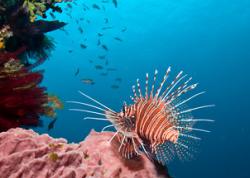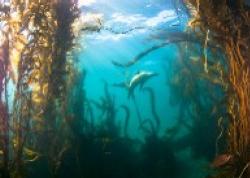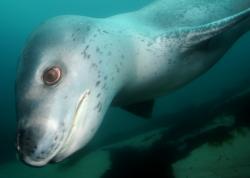Diving the Galapagos Islands
The Galapagos Islands, located 600 miles of the coast of Ecuador, are the islands of dreams for anyone interested in large pelagic life and prehistoric land critters. And if the word “endemic” gives you goose bumps, you will have found Nirvana. This is the place of legends for animals like the Galapagos tortoise, the flightless cormorants, salt spitting marine iguanas, whale sharks, schooling hammerheads, and yes, even penguins. A national park and world heritage listed area since 1978, the islands have become a popular destination for worldwide travelers and especially underwater photographers seeking unique subjects.
The geology of the Galapagos is one of the many things that make the islands so special. Geologically, they are newborns, only rising to the surface about 6 million years ago. Today, there are still active volcanoes on many of the islands which means the Galapagos is growing!
Amazing Galapaogos underwater video from a Jan/Feb 2016 Bluewater Photo trip, including hammerheads, Mola mola, penguins, marine iguanas, schools of mobulas, manta rays, galapagos sharks and much more.
Galapagos Islands Marine Life
Whale Sharks
Whale sharks, Rhincodon typus, gather in the northern islands of Wolf and Darwin during the northern hemisphere summer months. Over the past years, whale shark “season” has grown to include the fall. We have had spectacular whale sharks during the month of October and even into November. All of the adult whale sharks found here are female, many upwards of 10 meters in length. The waters of Wolf and Darwin are substantially warmer than the central islands which seems to be favored by the whale sharks.

Hammerhead Sharks
The schooling scalloped hammerheads, Sphymidae lewini, are also found mainly at Wolf and Darwin islands, often numbering in the hundreds.
Silky, Galapagos, and White Tip reef sharks
Many other shark species are found in the Galapagos islands as well. White tip reef sharks (Triaenodon obesus) are ubiquitous and found on most dive sites, North Seymour being one of the more popular for large numbers of white tips. Silky sharks (Carcharhinus falciformis)can be seen at Wolf and Darwin, sometimes in schools of 50 or more! Sunset is an excellent time to find this schooling behavior. And the namesake, Galapagos shark (Carcharhinus galapagensis), can be found at many of the islands. The Galapagos shark stands out on any dive because of their large size makes you stop and mumble through your regulator (now THAT’S a shark!). You can even see a Tiger shark if you are lucky.

Eagle, Cownose and Manta Rays
There are many ray species that ply the Galapagos waters but these four are generally the most interesting to the underwater photographer. Eagle rays can be found at Wolf and Darwin often in large shoals just hanging off the reef in the current waiting for you to bracket a gazillion shots. Manta rays are often found at Cape Marshall, though the site often has low visibility and is difficult for photography. Sometimes as well at N. Seymour. Cownose rays can often be found in shoals at Gordon Rocks.
Dolphins
Dolphin are found at both Wolf and Darwin islands and can be great photo subjects here in clear water. They are seen not uncommonly while diving and sometimes you can get in with snorkel gear with them as well. Listen carefully and you can often hear them on the dives. This will alert you to their presence. Wolf island is a place where it is possible to see dolphins hunting on the reef.
Sea Turtles
Green turtles are seen at many of the dive sites.
Sea Lions & Fur Seals
Sea Lions are great fun to dive with and can definitely give the photographer hours of challenging shooting as they dart around and you swing your camera every which way to try to capture them. You can find them in larger numbers at Cousin’s Rock and Isla Lobos. They are also found in clearer water at North Seymour and many other sites. Watch out for the big male beach masters!
You may have the opportunity to see Fur Seals in the water at Gordon Rocks on the outsides of the rock.
Schooling Fish
Schooling fish are basically everywhere in Galapagos including tuna, snapper, grunts, barracuda, jack, creole wrasse....well, name it...it’s probably there!


Hieroglyphic Hawkfish, photo by Randy Harwood
Seahorses, Batfish and Frogfish
Seahorses can be found in the grasses at cousin’s rock and the red lipped batfish at the back side of Darwin island on night dives and other sandy flats. Frogfish can be found as well at cousin’s rock and punta vincente roca.
Moray Eels
The fine spotted moray is a common resident at most dive sites and the rocky substrate at both Wolf and Darwin is literally strewn with them. Always look before you put your hand down on a rock to steady yourself for a shot!
Marine Iguanas, Penguins, Cormorants
These uncommon subjects are found at very specific locations. Penguins can be found at Bartolome. Here you snorkel near the shore and hope the penguins jump in to swim! Marine iguanas also spend time bathing in the sun, then drop into the water to feed. You can find them at NE Fernandina but bring your patience with you to get shots of them in the water. Cormorants may surprise you when they show up on a dive site. It’s not a common occurrence to find them in the water, so if one shows up, start shooting immediately! These animals are definitely bonuses if you can get them underwater. It’s MUCH easier to pull your camera out of the housing and go shoot them on land!

Endemics
One of the best reasons to dive the Galapagos island is the huge number of endemic species. According to Jack Grove, author of The Fishes of the Galapagos Islands, there are 44 fish species found here and nowhere else on earth. A great reason in itself to visit the islands!

Giant Tortoise
Best Dive Sites in the Galapagos Islands
The Northern Islands- Wolf and Darwin
Wolf and Darwin islands are located about 150 miles north of the central Galapagos Islands and have unique characteristics. Neither island is accessible for shore visits as their sheer cliffs would be impossible to scale. Because of this the islands are not visited by the “safari” boats, meaning the boats that are doing land tours only. The islands are left solely to the live aboard dive boats to enjoy.
Currents around Wolf and Darwin bring the warmest waters of Galapagos sometime reaching as high as 80 degrees. It is here you will find schooling hammerheads and whale sharks, dolphin and tuna schools, turtles and eagle rays. The prevailing current has also allowed larvae from various tropical reef fish such as the double saddle butterfly to the islands. Many of the reef fish here are not found in the other areas of Galapagos.
On one occasion on an October trip, we spotted a mother and calf humpback whale on the back side of Wolf at sunset. Always keep your eyes peeled here.
Darwin Island, "The Arch"
Darwin’s Arch is the landmark by which divers know they have found whale shark heaven during the northern hemisphere’s summer and fall months. It is not uncommon to find the world’s largest fish on 11 out of 12 dives here, sometimes multiple sightings on the same dive.
Diving with whale sharks is one of greatest thrills of a diver’s lifetime and when one is sighted the race is on. Keeping up with a moving whale shark can get the heart pumping. It is VERY easy to lose track of EVERYTHING when the whale shark shows up including NDL, air, depth, time and buddies!
Darwin’s Arch can also produce schools of hammerheads and silky sharks as well as turtles and dolphin. Keep your eyes out in the blue at all times! Also, keep an eye on the boobies (the birds!) A great shot is to get a booby’s head looking at you underwater as it sits on the surface.
Be sure to have a surface float and reel and if you lose the group and end up doing your safety stop in the blue, pop your float on your reel immediately or ditch the safety stop altogether. Strong currents can take you far fast and this way the dive boat will see you while you are still in range and can follow your float.
The famous "Darwin's arch"
Wolf Island
Wolf Island’s reputation definitely leans towards hammerheads in large schools and on occasion whale sharks. This is a fantastic place to find schools of eagle rays and also galapagos sharks. Always keep your eyes on the blue! It is not uncommon to find schools of tuna and jack sweep past you on your safety stop!
Central Islands
The Central islands of Galapagos offer some of the most varied diving in the world. You can find strong and mild currents, warm and downright ass chilling cold water, good to horrible visibility and batfish to baitfish to sharks.
North Seymour
North Seymour is a fun dive site because it is always changing. Visibility is often very good here and is generally dived on one of the first days of your trip. You scoot along with the current (mild to strong!) and things just pop out in front of you. It is a sea lion rookery so you’ll be cruising along when all of the sudden a sea lion is in your face, then gone, then back again, then gone, then spinning around you and if it’s a pup, it may take a quick nip at your head. Then all of the sudden a manta ray swims by, then an eagle ray. Then you come up to a small ledge and a hundred white tip sharks are hanging in the current. Then you come around a corner and there is a huge school of small barracuda. You just never know what’s in store at North Seymour.

Schooling grunts at North Seymour, photo by Randy Harwood
Cousin's Rock
Cousin’s Rock is a great place to find seahorses, octopi and sometimes frogfish. One side is a series of dramatic terraced ledges where the ever present creole fish hide from the ever hunting sea lions. Visibility is usually somewhat reduced here but there is still a lot to see and shoot. A perennial favorite.

Pacific Seahorse
Gordon Rocks
Due to it’s proximity to Puerto Ayora, Gordon Rocks is a favorite place for the last dives of the trip. There are two rocks with swirling currents between them, often causing you to perform figure eights. In between the rocks is where you can often find the little cownose rays and on the outside you can often find fur seals sleeping on the rocks often diving into the water and in front of your camera in the clearer water. This is another “surprise” dive as anything can show up here!
Punta Vicente Roca
Good macro dive for nudibranchs, the Red-lipped Batfish and Seahorses. We’ve heard Mola Mola are seen here but we’ve never seen that!
Comparing Galapagos to Cocos Island
Geologically Cocos and Galapagos lie on different tectonic plates and vary in age of a couple million years, Cocos being the younger. Underwater, there are definitely similarities in that they both have primarily a rocky bottom with very little corals and highly changeable currents, visibility and water temperature. These are not colorful coral reefs and have no soft corals. Both are known for large pelagics including schooling hammerheads and whale sharks, although Galapagos is much better for whale sharks and topside activities. They are both outstanding dive destinations!
Galapagos consists of many different islands where Cocos is a single island. On land, Galapagos offers an amazing array of terrestrial flora and fauna as well as a couple of small towns. On Cocos, there are a couple of outpost ranger stations and beautiful trails and waterfalls but not much in terms of animals other than introduced and now feral cats and pigs.
See also: Socorro, Cocos, or Galapagos: Comparing East Pacific's Top 3 Big Animal Diving Destinations

A Typical Dive in the Galapagos Islands
It’s really difficult to describe a “typical” dive here because there is huge variation. Due to both the Humbolt and Panamic currents water temperatures can range from 60 to 80 depending on which side of which island you are diving. The same holds true for visibility though Galapagos is not known for 100 foot vis. Currents are also highly variable. Expect current at the dive sites at Wolf and Darwin as well as North Seymour. Remember that current is your friend and sea life tends to accumulate in current making for more exciting diving. Dives can be challenging, and there can be swells and choppy seas. It’s not a place for beginners.

Diving Galapagos from a Zodiac
Galapagos Island Dive Safety
Use of GPS trackers, sound signaling devices and safety sausages is extremely important in remote areas like the Galapagos. We also recommend a reel and surface float in case you become separated from your dive guide.
Topside Excursions
Recently, regulations regarding diving and shore excursions have changed. It is now only possible to go ashore a couple of times if you are diving from a live aboard dive boat. You must go with a guide and remain on the marked trails at all times. These regulations are in place in an attempt to keep Galapagos as pristine as possible and not disturb the wildlife. You may have the chance to see sea lions, cormorants, fur seals, boobies including blue footed, red footed and nazca, marine iguanas, waved albatross, the famed Galapagos tortoises and more!
Best time to dive the Galapagos islands
When to go to the Galapagos
When to dive Galapagos depends on what you want to see. Most divers who go want to see whale sharks. The season for whale sharks runs from the end of June into November. This coincides with the dry season but also the garua season. The garua can bring cool winds as well as a light drizzle. Temperatures on land average in the 70’s. Seas are choppier during this time of the year.
December to May coincides with the hot season when humidity is high and temperatures are up in the 80s F. Seas are calmer and there is more rain during this time of the year, making May a great time to visit the Galapagos.
We have made numerous trips to Galapagos in October and have never failed to have fantastic whale shark encounters. Sometimes we do find the accompanying garua weather but when the whale sharks are there, who cares!! We have also made trips in May where we find calmer seas and hammerheads in shallower water when water temperatures are lower but no whale sharks.
Editors note - my pick for whale sharks months are Aug - Oct. YMMV!
On land, something is happening every month of the year as well. For example, in March the waved albatross arrive and in August frigatebird chicks are hatching.
Galapagos water temperatures
June to December is when the humbolt current is predominate. This brings cooler temperatures averaging 70-74 degrees though temperatures vary quite a bit throughout the archipelago, In some areas temperatures reach down as low as 59 degrees, especially around North Seymour.
December to June the warmer Panama current is predominate bringing warmer surface temperatures averaging 73-78.
Wolf and Darwin are always in the upper ranges of temperatures rarely dipping below 70 and often reaching 78 or even 80 degrees.
Galapagos underwater visibility
A good rule of thumb for Galapagos is always to expect everything to vary! Again, depending on which side of which island at which time of the year everything can change. Visibility tends to be best up at Wolf and Darwin reaching 80-100 feet and can drop as low as 30 ft at Gordon Rocks.
How to get to the Galapagos island
There are two gateway cities to fly from in Ecuador, either Quito or Guayaquil. Continental and American fly non stop from either Houston, Miami or Newark. Delta also flies four days a week from Atlanta. If you plan to spend any time sightseeing on the mainland, we recommend flying into Quito. If you just want to get to the islands head to Guayaquil. TAME or AeroGal will take you to either Baltra or San Cristobal depending on where your boat departs from. Read these tips for traveling to the Galapagos Islands to learn more about what to expect.
Other airlines that fly to Ecuador include Copa, Taca, Iberia, KLM, LanEcuador, Avianca and AirEuropa.
Best way to dive the Galapagos - Land or Liveaboard?
Hands down the best way to dive Galapagos is by liveaboard. There are a few land based operators but they simply don’t have the reach to get to many of the dive sites and liveaboard is the only way to get to the northern islands of Wolf and Darwin, which are an overnight steam away. You should get in about 20 dives on a liveaboard.
Book a Liveaboard Trip to the Galapagos
 Our sister company Bluewater Travel has lots of experience booking trips to Galapagos and 40+ other amazing scuba diving destinations. So if you want help planning your trip:
Our sister company Bluewater Travel has lots of experience booking trips to Galapagos and 40+ other amazing scuba diving destinations. So if you want help planning your trip:

View availability of some of the best liveaboards in Galapagos
Sharks seen while diving the Galapagos islands
Galapagos Underwater Photography Tips
Galapagos can be a difficult and very rewarding place to shoot. Conditions are highly variable, currents are often present and visibility ranges from 30-100’.
Sea Lions are very fun to shoot but move amazingly fast. Make sure and use focus lock on your DSLR. They will swim right up to your port so choose a wide angle lens.
Don’t forget to take a 60mm, 105mm or 100mm macro. There is a LOT of great macro in Galapagos from blennies and frogfish to seahorses and endemic batfish.
Use a wide angle zoom to give you the flexibility of shooting either a single shark or a school of sharks on the same dive.
Whale sharks swim a lot faster than you think. If you want to get close, don’t swim at them, swim to where they are going to be, position yourself in front and wait for them to swim past. They aren’t shy.
Hammerheads are notoriously shy. Its best to hide behind a rock and let them swim to you. Try to not release any bubbles as they get close, get your shot and then exhale!
Galapagos Lens Tips
I’m a big fan of using a wide angle zoom here. That gives you the flexibility of shooting a single shark, small school, large school or large shark like a whale shark. The Tokina 10-17 fisheye is the lens of choice for those shooting cropped sensor DSLRs and the venerable Nikkor 17-35 is perfect for full frame sensors. I’ve found the 10.5 to be a little too wide for most applications. Its difficult to get close enough to most of these subjects to effectively use it.
Make sure and use fast lenses here. Often the underwater world in Galapagos can be a little dark and a little green depending on conditions.
Further Reading
Best Dive Destinations for Underwater Photography

RECOMMENDED ARTICLES
SUPPORT THE UNDERWATER PHOTOGRAPHY GUIDE:
The Best Service & Prices on u/w Photo Gear
 Visit Bluewater Photo & Video for all your underwater photography and video gear. Click, or call the team at (310) 633-5052 for expert advice!
Visit Bluewater Photo & Video for all your underwater photography and video gear. Click, or call the team at (310) 633-5052 for expert advice!
The Best Pricing, Service & Expert Advice to Book your Dive Trips
 Bluewater Travel is your full-service scuba travel agency. Let our expert advisers plan and book your next dive vacation. Run by divers, for divers.
Bluewater Travel is your full-service scuba travel agency. Let our expert advisers plan and book your next dive vacation. Run by divers, for divers.

































